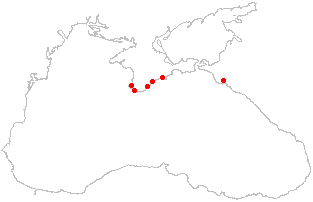 Synonyms: None
Synonyms: NoneEuphorbia peplis Linnaeus, 1753
 Synonyms: None
Synonyms: None
Common names: Russ: Molochay buterlakovidny; Turk: Kucuk sutlegen; Ukr: Molochay shchebrikovydny
Order: EUPHORBIALES
Family: EUPHORBIACEAE
Taxonomic descriptions: Annual herb. Stem is not completely developed, consisting of forks of cymose floscule with opposite leaves on the knots. Fleshy leaves are with subulate white stipuls. Nectaries are with linear white appendages. Stipuls consist of 2-3 subulate parts. Fruits are 3-4 mm long, seeds are smooth, 2.75-3 mm long.
 IUCN Status:
IUCN Status:
World level: NE
Black Sea Regional level: EN
Subregion level: EN (Ukraine)
Distribution:
Habitats type, Critical habitats, Limiting factors: The coastal zones of western and southern Europe, coasts of the Mediterranean, the Black Sea and the Caspian Sea. It can be found alone or with Eryngium maritimum, Centaurea arenaria on coastal saline sands.
Biology: Flowering during V-VIII, fruit-bearing - VII-X. Reproducing by seeds.
Population trends:
Threats: Recreation loading, tourism.
Conservation measures taken: The species has been entered in the Red Data Book of Bulgaria (1984).
Conservation measures proposed: To organize protected territories in places where it occurs.
References:
Compiled by: S.Dyatlov, T.Vasilieva